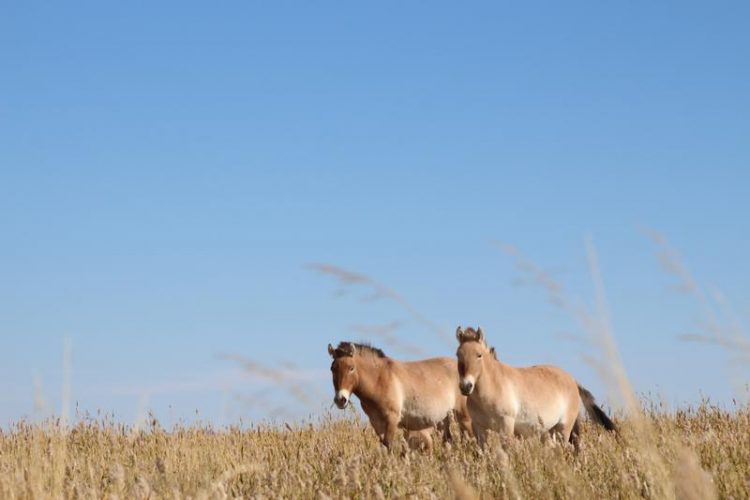The hairy past – Tail hair as an indicator of behaviour and ecology in horses

Przewalski's horses at an oasis in the Mongolian Gobi desert. Foto: Martina Burnik Šturm
A common method for learning more about an animal’s ecology and behaviour is to analyse the chemical composition of its hair. This involves the analysis of isotopes, which are variants of a chemical element with different atomic weights. The ratio of different isotopes of hydrogen, oxygen, carbon and nitrogen in a sample can provide important insights on water intake, nutrition and habitat.
Martina Burnik Šturm and Petra Kaczensky from the Research Institute of Wildlife Ecology at the University of Veterinary Medicine Vienna investigate the ecology of free-ranging horses and wild asses in the Gobi desert of Mongolia. In order to find out how different wild equid species live together in the Mongolian Gobi, what they eat, drink and how they migrate, the scientists look for answers in hair.
How “long” is one centimetre?
The researches quickly ran into one problem. What does one centimetre of hair actually mean in terms of time? Does one centimetre refer to as one week, one month or more? Measuring how fast hair grows in a particular species does not solve the problem because hair grows at different rates in each individual animal.
First author Burnik Šturm therefore developed a method to clearly align hair segments to time. The habitat of free-ranging equids in Mongolia helped her in this approach. The Mongolian Gobi is subject to extreme climatic conditions. Temperatures vary greatly at different times of year, and so does the composition of the chemical elements in the hair.
By comparing the isotope data from hair with satellite information freely available from NASA’s Earth Observing System Data and Information System (EOSDIS), she assigned a summer-winter rhythm to each hair. This allowed her to calculate the exact time corresponding to one centimetre of hair.
On average, the tail hair of Mongolian wild asses reaches one centimetre in 19 days. Przewalski’s tail hair takes 17 days and the tail hair of domestic horses only 13 days to grow one centimetre.
“We found that tail hair growth varies greatly between species and even between individuals. To assume that closely related species exhibit similar hair growth rates and to use average growth rates for individuals will most probably lead to incorrect results”, states Burnik Šturm.
“Isotope analysis of hair is a common method in the study of animal nutrition and migration. Our method makes it possible for the first time to establish exact time lines for an animal’s ecology and behaviour. Previous time lines were estimations and not entirely accurate. Now researchers have a relatively simple method with which to correctly interpret their data,” says Burnik Šturm.
Special life of wild equids in Mongolia
Tail hair is assumed to provide researchers with information about the ecology and behaviour of Przewalski’s horses, wild asses and free-ranging domestic horses in the Mongolian Gobi. All three species share the same habitat in a 9,000 square metres strictly protected area of southwest Mongolia. Closely related species usually compete for food. Moreover, the grassland in the region is quite barren. A key question for the researchers is: “What allows the animals to coexist in this region.” The project is still ongoing.
How does hair isotope analysis work?
For the isotope analysis, the tail hair is cut into one centimetre long segments and placed individually in little tin or silver cups before being burnt at a temperature of 1,450 degrees Celsius. Isotopes are then measured in the developing gases using mass spectrometry, a method to sort individual atoms by mass.
Today, isotope analysis is used in many different fields. The method can help to determine the regional origin of animals, food or natural fibres. Isotope analysis is also used to detect cases of doping or environmental contamination.
Service:
The article „A protocol to correct for intra- and interspecific variation in tail hair growth to align isotope signatures of segmentally cut tail hair to a common time line”, by Martina Burnik Šturm, Budhan Pukazhenthi, Dolores Reed, Oyunsaikhan Ganbaatar, Stane Sušnik, Agnes Haymerle, Christian C. Voigt and Petra Kaczensky was published in the journal Rapid Communications in Mass Spectrometry. DOI: 10.1002/rcm.7196
http://wiley-blackwell.spi-global.com/authorproofs/journal/RCM/20150401210907/RC…
About the University of Veterinary Medicine, Vienna
The University of Veterinary Medicine, Vienna in Austria is one of the leading academic and research institutions in the field of Veterinary Sciences in Europe. About 1,300 employees and 2,300 students work on the campus in the north of Vienna which also houses five university clinics and various research sites. Outside of Vienna the university operates Teaching and Research Farms. http://www.vetmeduni.ac.at
Scientific Contact:
Dr. Martina Burnik Šturm
Postdoctoral Researcher
Veterinärmedizinische Universität Wien (Vetmeduni Vienna)
T +43 1 20577-7151
sturm.martina@vetmeduni.ac.at
Released by:
Susanna Kautschitsch
Science Communication / Public Relations
University of Veterinary Medicine Vienna (Vetmeduni Vienna)
T +43 1 25077-1153
susanna.kautschitsch@vetmeduni.ac.at
http://www.vetmeduni.ac.at/en/infoservice/presseinformation/press-releases-2015/…
Media Contact
All latest news from the category: Agricultural and Forestry Science
Newest articles

NASA: Mystery of life’s handedness deepens
The mystery of why life uses molecules with specific orientations has deepened with a NASA-funded discovery that RNA — a key molecule thought to have potentially held the instructions for…

What are the effects of historic lithium mining on water quality?
Study reveals low levels of common contaminants but high levels of other elements in waters associated with an abandoned lithium mine. Lithium ore and mining waste from a historic lithium…

Quantum-inspired design boosts efficiency of heat-to-electricity conversion
Rice engineers take unconventional route to improving thermophotovoltaic systems. Researchers at Rice University have found a new way to improve a key element of thermophotovoltaic (TPV) systems, which convert heat…



